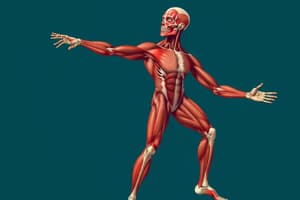Podcast
Questions and Answers
What is the primary function of the splenius capitis when both sides contract?
What is the primary function of the splenius capitis when both sides contract?
- Extends the head and neck (correct)
- Enables lateral flexion to the opposite side
- Facilitates head rotation to the opposite side
- Lowers the head and neck
Which of the following statements correctly describes unilaterally contracting splenius muscles?
Which of the following statements correctly describes unilaterally contracting splenius muscles?
- They facilitate lateral flexion and rotation to the same side (correct)
- They induce extension of the neck
- They primarily act to stabilize the neck
- They lead to lateral flexion and rotation to the opposite side
Which nerves provide innervation to the splenius capitis and splenius cervicis muscles?
Which nerves provide innervation to the splenius capitis and splenius cervicis muscles?
- Ventral primary rami
- Thoracic spinal nerves
- Dorsal primary rami (correct)
- Cervical sympathetic nerves
What type of movements do the splenius muscles allow for when acting bilaterally?
What type of movements do the splenius muscles allow for when acting bilaterally?
What is the position of the splenius cervicis in relation to the splenius capitis?
What is the position of the splenius cervicis in relation to the splenius capitis?
What is the primary action of the splenius capitis when both sides contract?
What is the primary action of the splenius capitis when both sides contract?
Which statement accurately describes the role of the splenius cervicis during unilateral contraction?
Which statement accurately describes the role of the splenius cervicis during unilateral contraction?
What type of muscle movement do the splenius muscles primarily contribute to?
What type of muscle movement do the splenius muscles primarily contribute to?
Which muscle is located beneath the splenius capitis and affects the cervical region?
Which muscle is located beneath the splenius capitis and affects the cervical region?
What structure provides innervation to the splenius muscles?
What structure provides innervation to the splenius muscles?
Flashcards are hidden until you start studying
Study Notes
Superficial Layer Muscles
- Superficial muscles involved in neck movement belong to the spinotransversales group.
Splenius Capitis
- Located at the upper part of the back and neck.
- Bilateral contraction extends the head and neck.
- Unilateral contraction facilitates lateral flexion and rotation of the head to the same side.
Splenius Cervicis
- Positioned beneath the splenius capitis, affecting the cervical region.
- Bilateral extension of the neck.
- Unilateral action allows for lateral flexion and rotation to the same side.
Nervous System Involvement
- Innervation comes from the dorsal primary rami (dpr nerve).
- Segmental roots connect to spinal nerves to enable muscle movement.
Muscle Actions
- Both splenius capitis and splenius cervicis assist in head and neck extension.
- They contribute to lateral flexion and head rotation, all movements occurring ipsilaterally (to the same side).
Summary of Functions
- Actions of splenius muscles include both bilateral and unilateral movements.
- Essential for effective head positioning and mobility.
Studying That Suits You
Use AI to generate personalized quizzes and flashcards to suit your learning preferences.




